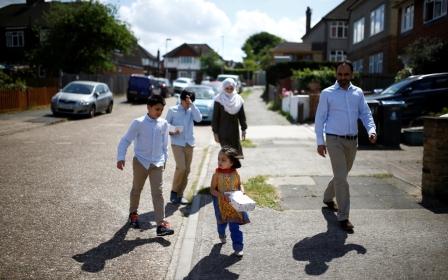Prevent: Shawcross review will lead nowhere, that's why we've launched our own

It is shocking, sad and frustrating, but perhaps not surprising, that an 11-year-old Muslim boy in Britain today can be referred to counter-terrorism authorities for wanting to give money to the downtrodden.
The bright and articulate boy was recently referred under the government’s highly criticised Prevent programme after an exchange with his teacher at school. Asked during a class discussion what he would do if he had lots of money, he replied: “I would give alms to the oppressed.”
These might seem a harmless comedy of errors - but each has brought a Prevent intrusion into a young person's life that will never be forgotten
Immediately shunting a Muslim child into a securitised framework, the teacher thought he had said he would “give arms to the oppressed”, and reported him to Prevent.
A Prevent referral always makes it into the statistics, even when it is false. This pushes up the numbers, exaggerating the “threat of extremism” and concealing the traumatic toll of the programme on children and parents.
During a Prevent referral, the targeted individuals - even young children - are interrogated, sometimes by counter-terrorism authorities. Our records show this can happen to children without their parents being present. Their data is collected and captured in a police database, alongside that of criminals. It can be scarring for life.
New MEE newsletter: Jerusalem Dispatch
Sign up to get the latest insights and analysis on Israel-Palestine, alongside Turkey Unpacked and other MEE newsletters
The highest number of Prevent referrals occur in the education sector, including many young children. Between April 2015 and April 2018, a total of 532 children under the age of six, and 1,181 children between six and nine, were referred under Prevent.
Portfolio of evidence
The latest “alms” faux pas carries the same hallmarks as other similar cases, in a growing portfolio of evidence against Prevent.
These include cases such as the Muslim child who was referred for saying “cucumber” (a Prevent-wired teacher interpreted this as “cooker bomb”), the “terraced house” case (interpreted by staff as “terrorist house”), and the Abu Bakr al-Siddique T-shirt case (referencing an important Islamic figure, but an Islamic State-spooked teacher read it as “Abu Bakr al-Baghdadi”).
There are more: they’ve taken on titles in advocacy circles such as “the Fortnite case”, “the Toy Story case”, and so on.
To the unaffected outsider or the Prevent profiteer, these might seem a harmless comedy of errors - but each has brought a Prevent intrusion into a young person’s life that will never be forgotten.
The historic response of the Prevent industry to these shocking cases has been to downplay such “incidents” as misapplications and anomalies that can be fixed. We hear repeatedly that these are issues of mistaken practice rather than issues of policy.
But the cases show quite the opposite: indeed, the problem with Prevent is the policy itself. Its frameworks, guidelines and overriding assumptions are based on a suspicion that has a cataclysmic scenario as its teleological endpoint. This suspicion, built around an enemy identity, is injected into the imaginations of frontline workers through Prevent training; chiefly impacted are those who demonstrate Islamic beliefs and practices. As such, even the most mundane expressions can be cause for acceleration to counter-terrorism police.
Fuelling Islamophobia
A study of its history shows clearly how Prevent rides upon, and gives justification to, deep-seated, inaccurate doubts about Muslims, fuelling a wider fear and hatred of Islam. It combines these “war on terror” mechanics with a pervasive and carefully maintained public fear, seeking to justify itself based upon paranoid and discriminatory notions of how to “ensure” national security.
Prevent, shunted into law under the banner of “safeguarding”, subsequently spread into schools and social work, resulting in the criminalisation of scores of young people. It has divided the public sector, because social work, education and health - in order to function properly - are not supposed to be coupled with politics and security.
The fact that other communities are now also being caught in the dragnet of Prevent does not negate the fact that it still mainly targets Muslims
And people, let alone children, are never supposed to be presumed criminals.
Now, as a third “review” of Prevent is underway, Muslims and others who have come under its scrutiny are bracing for a further entrenchment of the programme. For 10 years, voices opposed to Prevent have been ignored, and the last "review" and the many iterations have been used only to expand Prevent’s reach and deepen its policing of thought.
This has been demonstrated by its steady creep in scope. It has widened its stated aims in 2015, from flagging “violent extremism” to combatting “non-violent extremism”, and now the ever-expandable aim - as proposed by Prevent’s flag-waver, the Commission for Countering Extremism - to stop “hateful extremism”.
It has also expanded, while still disproportionately targeting Muslims, to include new categories of “extremism”, such as the eye-popping catch-all of “mixed, unstable or unclear ideology”, which has targeted environmentalism and climate activism.
Growing advocacy
The farcical nature of the “review” process reached its peak when Lord Carlile was appointed to head the latest one, only to be deposed by a legal challenge. William Shawcross then stepped up to the plate, no doubt due to his vigorous support of some of the worst “war on terror” policies.
Consequently, almost 600 individuals and organisations have boycotted the current review, which has become known, tellingly, as the Shawcross review.
But it is not just about Shawcross. With its terms of reference, the review moves further away from those impacted by Prevent, while failing to address its ethically and legally questionable pre-crime bases and its nebulous ideas of what constitutes “extremism” (which nobody, more than a decade on, has legally defined).
The fact that other communities are now also being caught in the dragnet of Prevent does not negate the fact that it still mainly targets Muslims. It does, however, mean that more people are beginning to join the advocacy against Prevent.
Those impacted by Prevent, and those who have taken a principled stance against it, have come together to form a People’s Review of Prevent, which will use evidence gathered on how the programme has impacted ordinary people and organisations. This newly launched platform is calling for submissions from all those impacted by Prevent, whether or not they have spoken up before.
We hope that the People’s Review will serve as a record for future generations, who will be able to trace how Prevent came into being - and that it will be used to hold to account those who profit from its harms.
The views expressed in this article belong to the author and do not necessarily reflect the editorial policy of Middle East Eye.
Middle East Eye delivers independent and unrivalled coverage and analysis of the Middle East, North Africa and beyond. To learn more about republishing this content and the associated fees, please fill out this form. More about MEE can be found here.






